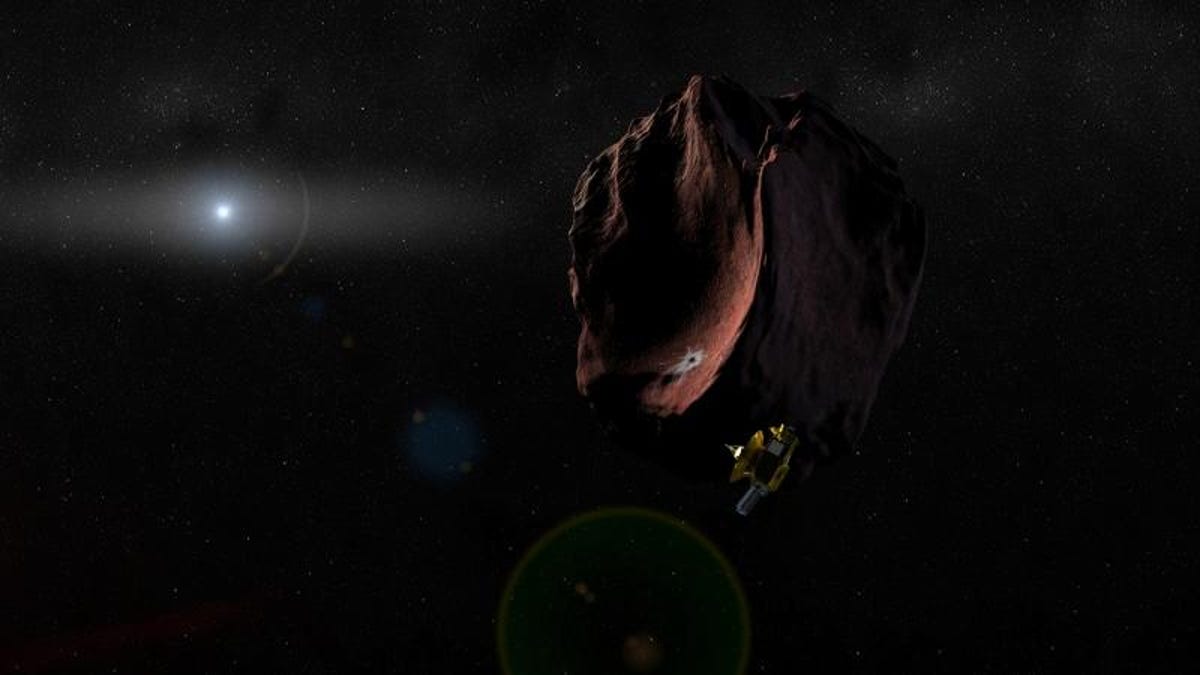NASA shutdown: Agency could be dark during historic New Year's missions
The space agency will not broadcast a historic flyby of mysterious space rock Ultima Thule if the US government shutdown continues into 2019.

Here is Ultima Thule in an artist's rendition.
Ringing in the new year with NASA was meant to be historic.
Two NASA spacecraft on separate missions are set to rendezvous with their rocky targets over New Year's Eve and New Year's Day. Earth-bound stargazers were supposed to be able to follow along via NASA. But the US government is currently in a shutdown due to a dispute in funding for President Donald Trump's proposed border wall. Part of the shutdown means that funding for the agency has currently expired. And no money coming in means little public viewing of space activities.
Thus, it's going to get a little trickier waiting for the Osiris-Rex spacecraft to enter orbit around the asteroid Bennu or seeing the New Horizons spacecraft send back images of Ultima Thule, the most distant world we've yet to explore and a billion miles past Pluto.
NASA officially shut down Saturday. Of NASA's 17,586 staff, the vast majority are staying home with no guarantee of pay, while 1,481 remain active and another 2,189 are "on call," exempted from the furlough. This ensures that NASA can continue to carry out support for the International Space Station and its crew, as well as enable satellite missions and emergency services to continue safely.
It's not all bad news right now, though.
Jim Bridenstine, NASA's administrator, tweeted Thursday that social media accounts for the upcoming missions over New Year's have been spared the woe of the government shutdown because they were "forward funded."
Expect to see the @NASANewHorizons social media accounts continue to operate. The contract for these activities was forward funded. This applies to @OSIRISREx and NASA TV too. @NASA will continue to stun the world with its achievements!
— Jim Bridenstine (@JimBridenstine) December 28, 2018
NASA's live stream is currently offline, however, and the agency is redirecting people to NASA TV, which it states will show live events. The NASA public relations team is unable to publicize the events and send out press releases during the shutdown because they aren't exempt from the furlough.
Previous government shutdowns, in January and February this year, lasted no longer than three days. But this shutdown could continue into the new year. As recently as Thursday, at least one US senator suggested there's "no end in sight".
So exactly what we will get to see over the New Year seems up in the air. However, all hope isn't lost. Here's where you can catch the action for NASA's historic missions:
Where to watch Osiris-Rex enter Bennu's orbit
The window for the record-breaking Osiris-Rex to get into orbit around the asteroid Bennu opens on New Year's Eve. While this mission doesn't quite have the appeal of being a billion miles beyond Pluto, it will eventually be the first time an asteroid has been sampled by NASA. Osiris-Rex will reach out and high-five Bennu, blasting up a ton of rock from its surface, grabbing some and then flying back to Earth in September 2023.
To follow along as Osiris-Rex places itself into the closest orbit of any spacecraft around a planetary body ever, there are several Twitter accounts worth keeping an eye on. The Lunar and Planetary Laboratory at the University of Arizona will keep you updated, and the Osiris-Rex website should have you covered if you're waiting for any images to come back from the spacecraft.
It doesn't appear NASA will be offering live coverage of this event. The spacecraft had its moment in the sun back on December 3 when it first arrived at Bennu.
Where to watch the New Horizons Ultima Thule flyby
It's the most distant world we will ever have explored, and New Horizons is set to snap photos of Ultima Thule when it passes the enigmatic rock in the outer reaches of our solar system. Ultima Thule flies around in the Kuiper Belt way out past Pluto. New Horizons is set to come within 2,200 miles of Ultima Thule's surface, hopefully beaming back images from a world we know very little about.
NASA is directing interested viewers to head to the Johns Hopkins Applied Physics Laboratory YouTube channel, which will simulcast a live stream along with the New Horizons homepage. Principal investigator Alan Stern is also directing viewers to the Applied Physics Laboratory's Twitter and to his own New Horizons Twitter account for mission updates.
Of course, there is the hope that the political impasse is resolved before all this occurs, which would set NASA back up with all the media tools at its disposal.
NASA turns 60: The space agency has taken humanity farther than anyone else, and it has plans to go further.
Star Wars Episode 9 is on its way: Everything we know about the final Skywalker film, from the cast to the release date and title.

